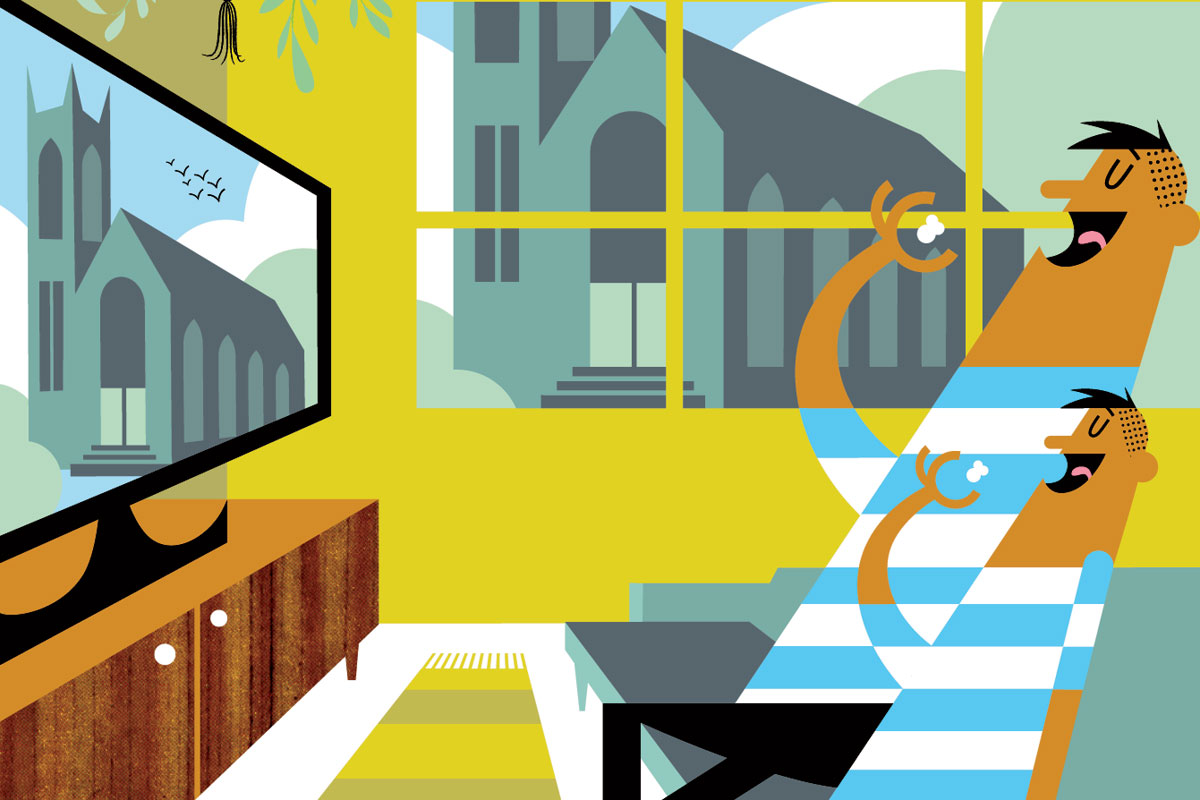These days, when he’s turned wispy with the approach of middle age, you can’t see Macaulay Culkin without counting: How many years has it been? How much life has been lived? How old have I become? When you see that 35-year-old flyspeck of an adult, you know for certain that you have aged and that you will die.
I wasn’t too far out of high school when I first saw Home Alone at Old Orchard, surrounded by teens in penny loafers and paisley. Now and then, when one of those kids leaned back, he’d leave a circular mousse stain on the seat.
Watching the movie, I was aware that John Hughes, as in so many of his movies, had set crucial scenes in streets and stores up and down the North Shore, most of them just a few miles from the theater. I filled in my internal map as the story unfolded, happy to be acknowledged and thrilled to be alive at such a moment. It was like Hemingway writing about Petoskey, Michigan, or Nelson Algren turning the Rainbo Club into literature. Here was another great local artist putting our familiar places on the big stage.
In The Moviegoer, Walker Percy, who I went swoony for around the same time, writes about how a place can be “certified” by film. It’s a special thing that happens when a place you frequent appears onscreen. Your existence is certified, made real.
To a true moviegoer, the ultimate thing, nirvana-like, would be to see a movie that the theater in which you were seeing that movie appeared. A vortex or eddy would form, an infinite regress, as when two mirrors face each other.
Which is something like what happened in 1990 when I watched Home Alone. One by one, the places of my first fumbling high school sprees were illuminated and preserved: the store in downtown Hubbard Woods where Kevin flees the old man; the skating rink in the park where he makes his getaway; the train station where the Chicago and Northwestern highballs it toward far-off, mysterious Chicago.
The house itself, in Winnetka, has become a shrine, visited by tourists from around the world. It would be a strange place to grow up. It’d be like living in the White House, the people’s house. It belongs to everyone and no one.
The penultimate scene was shot at two churches. The exterior is Trinity United Methodist Church in Wilmette. The interior is Grace Episcopal Church in Oak Park—that’s where Kevin, at loose ends, goes in search of warmth, solace. It’s funny to find such a spiritual scene tucked inside a broad family flick, the stained glass and the silence, the choir and the suffering Jesus, the small boy with his head down in the pew. I’ve been told that people visit Trinity in search of whatever it is Kevin found in the movie—strength, well-being, understanding. Of course, what they’re really looking for is the world as it was in 1990.
I’ve watched Home Alone perhaps a million times. It’s changed on me, as movies do. At first, I was all for the terrific punishment meted out on the adults and for how the kid learns to handle himself. I’ve since come to identify with the grownups, the robbers. It happens when you become a parent. You switch sides. Critics chided the movie for all the hurtin’ Kevin heaps upon the crooks: paint can in face, blowtorch on scalp, red-hot doorknob, and, worst of all, black ice on stairs. Entertainment Weekly, which, 25 years ago, gave the movie a D, described it as a “sadistic festival of adult-bashing.” Though such criticism once struck me as nuts, I’ve become sympathetic to the plight of the frail human body. During some scenes, I think only of slow recovery, of the years spent in prison rehab, trying to get that knee to work again.
For the most part, I’m astonished by how well the movie holds up. John Candy as the polka bum still gets me. Catherine O’Hara as the panicked mom still gets me. And the star, Culkin, was as great in his way as Jackie Coogan was in Chaplin’s The Kid. You can’t stop watching. It may be the best movie in the John Hughes oeuvre. Sneaky. Like all great comedies, it’s a horror flick disguised as family fare. Prescient, too. After all, what has the last quarter century been but a slow realization that there are no adults, that, since the ’80s or ’90s, we’ve all been home alone? The robbers are coming, and there is no one to save us.
If, in the year of Home Alone’s release, you were to have watched a 25-year-old movie, you could’ve chosen between Doctor Zhivago and The Sound of Music. That’s how far we’ve come: To this new crop, our childhood is as far in the past as The Sound of Music was to us. But Home Alone is better than The Sound of Music, way more of this moment. If you don’t believe me, watch it with your kids. All the jokes work, the kicker still leaves them satisfied. When it’s over, if you happen to live on the North Shore, you’ll step out into a landscape created by John Hughes. You are in his world, even if you don’t know it.




